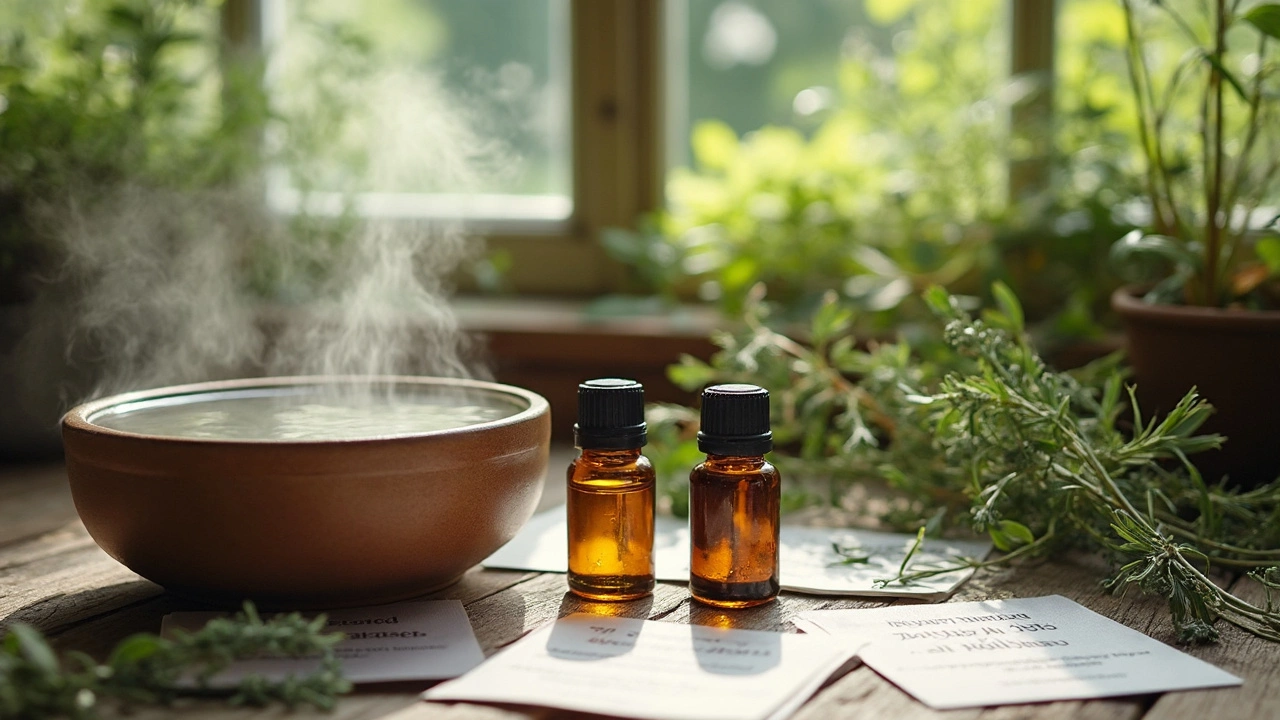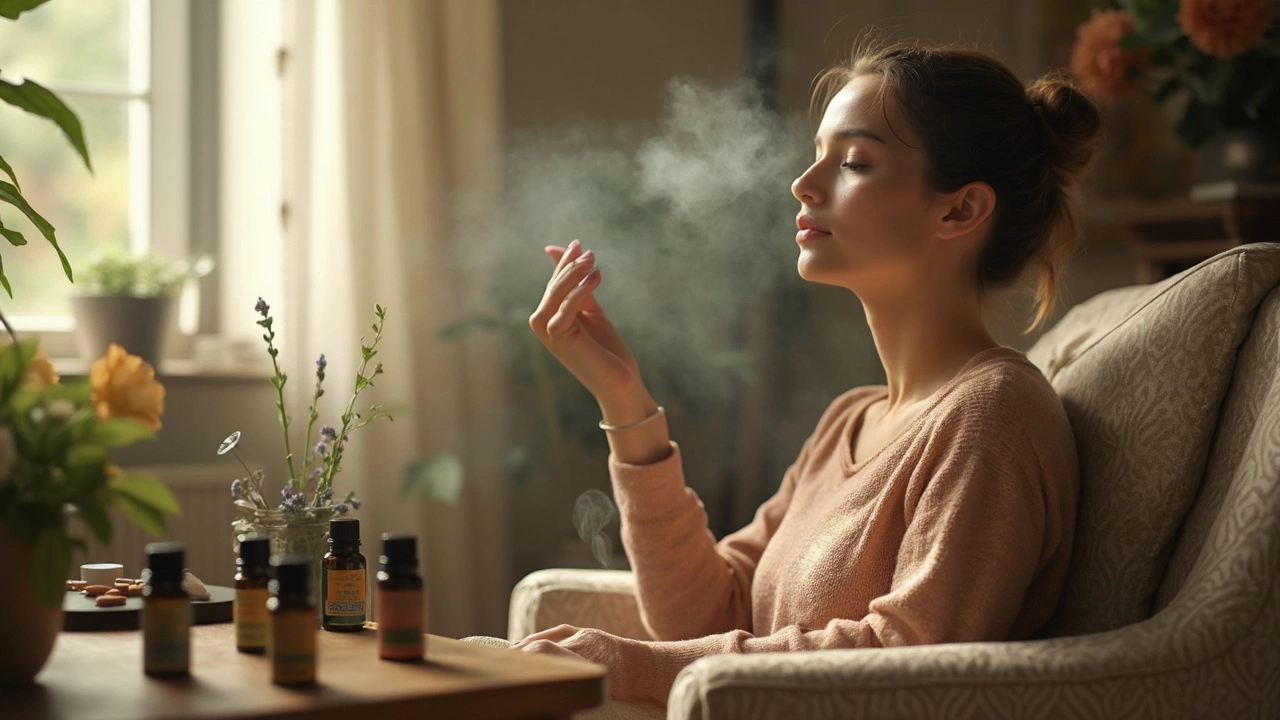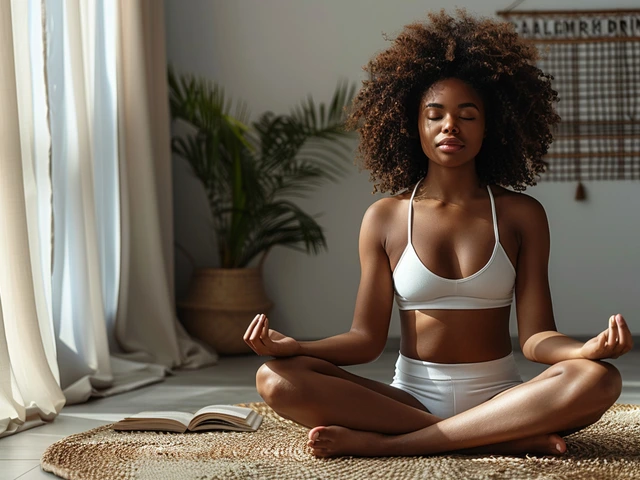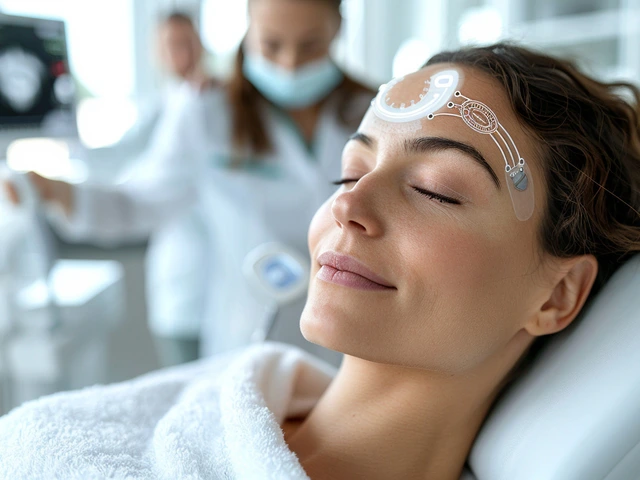Feeling frazzled is just part of modern life, but you don't need a fancy spa day to take the edge off. Aromatherapy—basically using natural scents from plants—can help you chill out almost anywhere. And no, you don’t need to memorize Latin names or own an entire shelf of obscure oils. You just need a few basics to get started.
Most people are surprised how quickly a simple scent can change their mood. Ever notice how the smell of orange makes you feel brighter or a whiff of lavender helps you let go? That’s your brain reacting in real time. In a pinch, reaching for an essential oil can work faster than doomscrolling for stress relief.
Before grabbing just any oil, it helps to know which ones actually work for stress. Look for real essential oils—nothing fake and definitely no ‘fragrance oils’ loaded with chemicals. Once you’ve got the good stuff, you’re set to try out these simple techniques, whether you’re on your lunch break or winding down after a long day.
- Why Scent Works for Stress
- Choosing Your Essential Oils
- Aromatherapy Diffusers: Fast Calm at Home
- On-the-Go Relief: Inhalers and Roll-Ons
- Easy DIY: Stress-Busting Baths and Showers
Why Scent Works for Stress
Okay, so here’s what’s cool: your nose doesn’t just help you smell stuff—it’s directly linked to your brain. When you sniff an essential oil, tiny scent molecules travel up your nose and hit the olfactory bulb, which is right next to the part of your brain that handles emotions and memories. That’s why something as simple as smelling lavender can take the pressure down fast.
It’s not just wishful thinking, either. A real study from the National Institutes of Health found that people who inhaled lavender oil before a stressful task had lower heart rates and felt calmer compared to those who breathed plain air. In another big review of stress research, several essential oils—including lavender, bergamot, and orange—were shown to lower stress markers in both blood pressure and self-reported anxiety.
Here’s a snapshot of how fast scents impact your body:
| Essential Oil | Time to Effect (Minutes) | Common Result |
|---|---|---|
| Lavender | 5-10 | Calms nerves, lowers tension |
| Bergamot | 5-10 | Boosts mood, reduces anxious feelings |
| Sweet Orange | 3-6 | Lifts mood, eases mental fatigue |
Why does this happen so quickly? It’s because the limbic system in your brain—your emotional command center—responds to scent within seconds. It even plays a role in how your body handles stress by influencing your heartbeat, breathing, and hormones. That’s why using aromatherapy for stress works faster than most people expect.
So if your brain feels fried or your heart’s pounding after a tough day, grabbing an essential oil isn’t just a “nice smell” thing. You’re actually short-circuiting your body’s stress response using natural chemistry. Pretty handy, right?
Choosing Your Essential Oils
Picking the right essential oils for aromatherapy is where lots of people get stuck, but honestly, you don’t need a dozen different bottles to start getting stress relief. Just a handful of the main stress-busters is enough for most situations. Quality matters way more than quantity—cheap, synthetic oils don't deliver the kind of results you want.
If you’re totally new, focus on a few proven oils. For stress, the top picks aren’t just random Instagram hype—there’s actual research backing them up. Lavender is the main fan favorite for stress; a real 2023 study from Osaka University shows it can lower heart rate and blood pressure after a rough day. Bergamot is another crowd-pleaser and even used in clinics in Italy to reduce anxiety. Chamomile, ylang ylang, and frankincense also have solid track records for calming the nerves. Here’s a quick rundown of what you might want to try:
- Lavender: Classic for stress, helps with sleep too.
- Bergamot: Uplifting, good for tense afternoons.
- Chamomile: Gentle and soothing, less likely to bother sensitive noses.
- Ylang Ylang: Great for unwinding, has a sweet scent some folks love at bedtime.
- Frankincense: Grounding and old-school, nice for meditation or winding down after work.
Labels can be confusing, but there are a few red flags to watch for. Always buy oils that list the plant’s Latin name and where it was grown. If it just says "fragrance oil," move on. Trustworthy brands will share how the oil was extracted (steam distilled or cold-pressed is good). Price is another clue—real pure oil is rarely dirt cheap.
Not sure where to get started? Here’s a quick cheat sheet of top picks for everyday stress relief, plus their average cost per 10ml bottle in the US this year:
| Essential Oil | Main Effect | Average Price (10ml) |
|---|---|---|
| Lavender | Relaxation, sleep | $10–$15 |
| Bergamot | Mood-lifting | $14–$20 |
| Chamomile | Calming, gentle | $20–$25 |
| Ylang Ylang | Unwinding, balancing | $12–$18 |
| Frankincense | Grounding, meditative | $17–$25 |
Once you pick an oil, store it somewhere cool and dark—kitchen cabinets work fine. Keep the lid tight because air will make it go bad faster. Start simple: even one bottle of lavender or bergamot goes a long way for stress relief, and you can experiment with others once you know what works for you.

Aromatherapy Diffusers: Fast Calm at Home
If you want stress-busting scents in your space fast, you can’t really beat a good aromatherapy diffuser. The main job of a diffuser is to spread the smell of your favorite essential oils all over the room—no candles, flames, or matches needed. These things are such a popular tool that a 2023 survey showed over 60% of people who use essential oils go for diffusers first.
There’s more than one kind, but here are the most common types you’ll see:
- Ultrasonic diffusers: Use water and ultrasonic waves to send a cool mist filled with essential oil into the air. They double as mini humidifiers, which can help with dry air too.
- Nebulizing diffusers: No water needed. They break the oil into super tiny droplets, giving you a strong scent—pretty much instant stress support.
- Heat diffusers: Use gentle heat to release the oil scent. They’re simple, but the scent can be a little weaker, and heat may change the oil’s natural benefits.
- Evaporative diffusers: A fan blows air through a pad or filter with oils on it. They’re silent and portable, but the scent may fade sooner.
Most people stick with ultrasonic because they’re affordable, easy, and don’t change how oils work. To use one, just:
- Add water up to the fill line.
- Add 5-10 drops of your chosen stress-relieving essential oil—think lavender, bergamot, or cedarwood.
- Turn it on and let the mist do its thing. It’s that simple.
If you’re wondering why this works, here’s what’s cool: when you breathe in those essential oil molecules, your brain’s limbic system gets involved. That’s the part linked to mood and stress. Certain oils (like lavender) have real science behind them—studies show lavender oil can reduce anxiety levels by up to 30% in about 15 minutes.
| Diffuser Type | Best For | Strength of Scent |
|---|---|---|
| Ultrasonic | Everyday home use | Moderate |
| Nebulizing | Fast, strong scent | High |
| Heat | Small rooms, gentle scent | Low |
| Evaporative | Portable, quick set-up | Medium |
If you want quick, effective aromatherapy for stress, set up your diffuser where you hang out most. Living rooms, bedrooms, or even your home office can all become little chill-out zones in minutes. Just make sure you clean your diffuser every few days so mold or gunk doesn’t mess with your vibe—or your health.
On-the-Go Relief: Inhalers and Roll-Ons
Life doesn’t stop just because you’re stressed. But you also can’t drag a diffuser and a stack of essential oils everywhere. That’s why pocket-sized aromatherapy tools like personal inhalers and roll-ons are popular—not just a Instagram trend, but science-backed helpers against stress. These guys make it super easy to use aromatherapy anywhere: in traffic, at your desk, even during a tense family dinner.
Inhalers are literally tiny tubes (think lip balm size) filled with a cotton wick that soaks up essential oils. You uncap it, take a deep breath or two, and you’re good to go. University of Maryland studies found that handheld inhalers with calming oils like lavender or bergamot actually helped participants feel less anxious fast—often in under two minutes.
Roll-ons are just as low-maintenance. They’re usually tiny glass bottles with a metal rollerball on top, pre-mixed with essential oil and a carrier oil (like jojoba). You swipe a little onto your wrists, behind your ears, or on your temples—wherever you catch the scent the most. Super gentle and no mess.
Here’s a simple guide on how to use both:
- Personal Inhaler: Take off the cap, hold the tube near your nose (not touching), and inhale deeply for 2-3 seconds. Repeat as needed.
- Roll-On: Glide the roller over pulse points like your wrists, inside your elbows, or the back of your neck. Let it absorb—don’t rub in too hard—or just breathe it in from your skin.
Want to make your own stress-busting blend? Try this DIY recipe:
- Lavender (5 drops)
- Bergamot (3 drops)
- Sweet orange (2 drops)
- Add to a 10ml roll-on bottle, fill with a neutral carrier oil (like fractionated coconut oil), and you’re set.
And if you’re asking—are these really effective? Check out this quick breakdown from a 2023 aromatherapy user survey:
| Tool | % users reporting quick stress relief | Average time to feel effect |
|---|---|---|
| Inhalers | 72% | 2 minutes |
| Roll-ons | 65% | 5 minutes |
You can find all-in-one inhalers and roll-ons at pretty much any health store—or make your own for way less money. Safe, portable, and totally non-fussy, these tools fit into any backpack, purse, or even your jacket pocket. That’s real on-the-go relief, no appointment required.

Easy DIY: Stress-Busting Baths and Showers
You don’t need a luxurious spa to get the calming benefits of aromatherapy at home. Turning your regular bath or shower into a stress-relief zone is actually pretty straightforward. Warm water helps your body relax, and when you add essential oils, you give your brain an extra cue to let go of tension.
If you’ve got a bathtub, grab a few drops of your favorite essential oil—lavender, chamomile, and bergamot are proven by researchers to lower anxiety. It’s best not to dump oils straight into the water though, since pure essential oils don’t mix well with just water and can irritate your skin. Here’s how to do it right:
- Mix 5-10 drops of essential oil with a tablespoon of carrier oil (like coconut or sweet almond oil).
- Swirl this mixture into your bath just before you get in.
- If you want bubbles, use an unscented, natural bubble bath to avoid clashing scents.
For shower lovers, aromatherapy is just as simple. Put a few drops of your chosen oil on a washcloth or cotton pad and pop it on the floor of your shower—away from the direct water stream but close enough for the steam to pick up the scent. Eucalyptus is a superstar for this—it’s not only relaxing but also helps clear your head if you’re feeling stuffy or foggy.
Always go for pure, real essential oils. Anything labeled as ‘fragrance oil’ pretty much means it’s synthetic stuff, and that won’t give you the same calming effect.
One last tip: Never use more than 10 drops of oil at a time in the bath, and never put essential oils directly on your skin without diluting. A little goes a long way, and you want the experience to be relaxing, not irritating.





